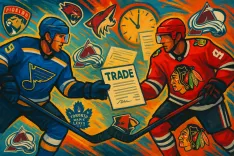NHL Salary Cap Surge Sparks Offer Sheet Speculation, But No Moves Yet Made

NHL Salary Cap Spike Promises Offseason Movement
The NHL's salary cap is set for a substantial increase, jumping from $88 million in the 2024-25 season to $95.5 million for 2025-26. This has ignited speculation about the potential for offer sheets as teams look to capitalize on the newfound cap flexibility.
For those unfamiliar, an offer sheet is a contract proposed by one team to a restricted free agent (RFA) from another team. If the original team chooses not to match the offer within seven days, they receive compensation in the form of draft picks. With the salary cap having flattened for several years, player movement opportunities were limited, making this increase particularly noteworthy, especially with projections suggesting the cap will reach $113 million by 2027-28.
Why No Offer Sheets Yet?
As training camps approach, it's striking that no RFAs have signed offer sheets this summer, especially following the signings of players like Philip Broberg and Dylan Holloway last season by the St. Louis Blues, who proved instrumental in helping their team secure a playoff spot.
One reason for the lack of offer sheets could stem from the recent ratification of a new collective bargaining agreement (CBA) by the NHL and NHL Players' Association, which will take effect on September 16, 2026. This agreement changes several aspects of player contracts, including reducing the maximum contract terms. Some general managers might be hesitant to commit to RFAs before the new CBA is in place.
Capitalizing on Future Certainty
The sizable rise to a $95.5 million cap has left many teams with considerable cap space—at least seven teams have over $10 million available. However, general managers may prefer to strategize under the upcoming cap projections where allocated budgets could be significantly higher. Management can also make better estimates regarding future acquisitions, whether through trades, unrestricted free agents, or potential offer sheets.
High-profile RFAs like Anaheim Ducks' Mason McTavish, despite considerable cap space, did not draw offers likely due to the Ducks' ability to match any potential signing. Players such as Toronto Maple Leafs winger Matthew Knies have shown loyalty to their teams, preferring to remain rather than pursue offers from rival clubs.
The Potential Costs of Offer Sheets
The implications of signing an RFA through an offer sheet can be expensive, with compensation rates escalating sharply based on contract value. For instance, an offer sheet yielding an average annual value (AAV) of between $4.68 million and $7 million would cost a team their first- and third-round picks. The cost continues to increase, with taller penalties for higher AAVs. This financial and draft capital risk might deter general managers from making offers.
The Appeal of Future Stars
Additionally, the chance to acquire future star players could have led some teams to think twice about pursuing RFAs this offseason. Teams are eyeing the 2026 NHL draft, where the highly coveted Gavin McKenna from Penn State is projected to be the first overall pick. Teams might hesitate to risk their future draft capital when the rewards could be much greater.
Only time will tell whether the anticipated offer sheets materialize. With general managers now calculating their strategies more carefully in light of the cap increase and the new CBA, the landscape could shift swiftly as the season nears.









